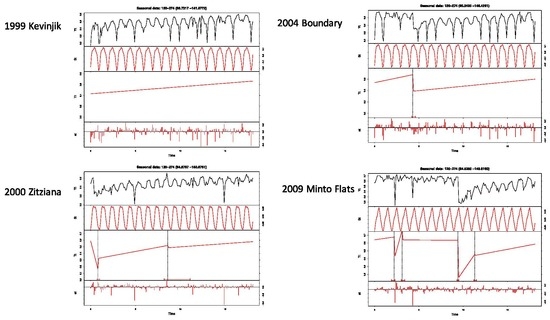Recovery Rates of Wetland Vegetation Greenness in Severely Burned Ecosystems of Alaska Derived from Satellite Image Analysis
Abstract
1. Introduction
2. Materials and Methods
2.1. Landsat Burn Severity Classes
2.2. MODIS Vegetation Index Time Series
2.3. Elevation and Land Cover Map Layers
2.4. Statistical Analysis Methods
3. Results
3.1. Wetland NDVI Changes within Large Wildfires 1999–2009
3.2. Statewide Wetland NDVI Change for HBS Areas 2000–2015
4. Discussion
5. Conclusions
Funding
Acknowledgments
Conflicts of Interest
References
- Bixby, R.J.; Cooper, S.D.; Gresswell, R.E.; Brown, L.E.; Clifford, D.N.; Dwire, K.A. Fire effects on aquatic ecosystems: An assessment of the current state of the science. Freshw. Sci. 2015, 34, 1340–1350. [Google Scholar] [CrossRef]
- Richardson, C.J. The Everglades: North America’s subtropical wetland. Wetl. Ecol. Manag. 2010, 18, 517–542. [Google Scholar] [CrossRef]
- Boelman, N.T.; Stieglitz, M.; Rueth, H.M.; Sommerkorn, M.; Griffin, K.L.; Shaver, G.; Gamon, J. Response of NDVI, biomass, and ecosystem gas exchange to long-term warming and fertilization in wet sedge tundra. Oecologia 2003, 135, 414–421. [Google Scholar] [CrossRef] [PubMed]
- Epting, J.; Verbyla, D.L. Landscape level interactions of pre-fire vegetation, burn severity, and post-fire vegetation over a 16-year period in interior Alaska. Can. J. For. Res. 2005, 35, 1367–1377. [Google Scholar] [CrossRef]
- Goetz, S.J.; Bunn, A.G.; Fiske, G.J.; Houghton, R.A. Satellite observed photosynthetic trends across boreal North America associated with climate and fire disturbance. Proc. Natl. Acad. Sci. USA 2005, 103, 13521–13525. [Google Scholar] [CrossRef] [PubMed]
- Potter, C. Regional analysis of MODIS satellite greenness trends for ecosystems of interior Alaska. GISci. Remote Sens. 2014, 51, 390–402. [Google Scholar] [CrossRef]
- Potter, C.; Li, S.; Crabtree, R. Changes in Alaskan tundra ecosystems estimated from MODIS greenness trends, 2000 to 2010. J. Geophys. Remote Sens. 2013, 2, 107. [Google Scholar] [CrossRef]
- Kasischke, E.S.; Turetsky, M.R. Recent changes in the fire regime across the North American boreal region: Spatial and temporal patterns of burning across Canada and Alaska. Geophys. Res. Lett. 2006, 33, L09703. [Google Scholar] [CrossRef]
- Potter, C.S. Ecosystem carbon emissions from 2015 forest fires in interior Alaska. Carbon Balance Manag. 2018, 13, 2. [Google Scholar] [CrossRef] [PubMed]
- Johnstone, J.F.; Chapin, F.S.; Hollingsworth, T.N.; Mack, M.C.; Romanovsky, V.; Turetsky, M. Fire, climate change, and forest resilience in interior Alaska. Can. J. For. Res. 2010, 40, 1302–1312. [Google Scholar] [CrossRef]
- Kasischke, E.S.; Johnstone, J.F. Variation in postfire organic layer thickness in a black spruce forest complex in interior Alaska and its effects on soil temperature and moisture. Can. J. For. Res. 2005, 35, 2164–2177. [Google Scholar] [CrossRef]
- Kasischke, E.S.; Verbyla, D.L.; Rupp, T.S.; McGuire, A.D.; Murphy, K.A.; Jandt, R.; Barnes, J.L.; Hoy, E.E.; Duffy, P.A.; Calef, M.; et al. Alaska’s changing fire regime -implications for the vulnerability of its boreal forests. Can. J. For. Res. 2010, 40, 1313–1324. [Google Scholar] [CrossRef]
- Viereck, L. The Effects of Fire in Black Spruce Ecosystems of Alaska and Northern Canada. In The Role of Fire in Northern Circumpolar Ecosystems; Wein, R.W., MacLean, D.A., Eds.; Wiley: Chichester, UK, 1983; pp. 201–220. [Google Scholar]
- Jiang, Y.; Rocha, A.V.; O’Donnell, J.A.; Drysdale, J.A.; Rastetter, E.B.; Shaver, G.R.; Zhuang, Q. Contrasting soil thermal responses to fire in Alaskan tundra and boreal forest. J. Geophys. Res. Earth Surf. 2015, 120, 363–378. [Google Scholar] [CrossRef]
- Brown, D.R.N.; Jorgenson, M.T.; Kielland, K.; Verbyla, D.L.; Praka, A.; Koch, J.C. Landscape effects of wildfire on permafrost distribution in Interior Alaska derived from remote sensing. Remote Sens. 2016, 8, 654. [Google Scholar] [CrossRef]
- Verbesselt, J.; Hyndman, R.; Newnham, G.; Culvenor, D. Detecting Trend and Seasonal Changes in Satellite Image Time Series. Remote Sens. Environ. 2010, 114, 106–115. [Google Scholar] [CrossRef]
- Verbesselt, J.; Hyndman, R.; Zeileis, A.; Culvenor, D. Phenological change detection while accounting for abrupt and gradual trends in satellite image time series. Remote Sens. Environ. 2010, 114, 2970–2980. [Google Scholar] [CrossRef]
- De Jong, R.; Verbesselt, J.; Schaepman, M.E.; de Bruin, S. Trend changes in global greening and browning: Contribution of short-term trends to longer-term change. Glob. Chang. Biol. 2012, 18, 642–655. [Google Scholar] [CrossRef]
- Eidenshink, J.; Schwind, B.; Brewer, K.; Zhu, Z.; Quayle, B.; Howard, S. A project for monitoring trends in burn severity. Fire Ecol. Spec. Issue 2007, 3, 3–21. [Google Scholar] [CrossRef]
- Miller, J.D.; Thode, A.E. Quantifying burn severity in a heterogeneous landscape with a relative version of the delta Normalized Burn Ratio (dNBR). Remote Sens. Environ. 2007, 109, 66–80. [Google Scholar] [CrossRef]
- Didan, K.; Munoz, A.B.; Solano, R.; Huete, A. MODIS Vegetation Index User’s Guide (MOD13 Series) 2016; Version 3.00, June 2015 (Collection 6); University of Arizona, Vegetation Index and Phenology Lab: Tucson, AZ, USA, 2016. [Google Scholar]
- Shao, Y.; Lunetta, R.; Wheeler, B.; Iiames, J.; Campbell, J. An evaluation of time-series smoothing algorithms for land cover classifications using MODIS-NDVI multi-temporal data. Remote Sens. Environ. 2016, 174, 258–265. [Google Scholar] [CrossRef]
- United States Geological Survey (USGS). Digital Elevation Model 300M Grid for Alaska, from Defense Mapping Agency 3-Arc Second 1x1 Degree 1, 250,000 Scale, Digitial Elevation Models. Source Data for Digital Shaded-Relief Image of Alaska, USGS Map I-2585; U.S. Geological Survey EROS Alaska Field Office: Anchorage, AK, USA, 2016.
- Selkowitz, D.J.; Stehman, S.V. Thematic accuracy of the National Land Cover Database (NLCD) 2001 land cover for Alaska. Remote Sens. Environ. 2011, 115, 1401–1407. [Google Scholar] [CrossRef]
- Kleiber, C.; Hornik, K.; Leisch, F.; Zeileis, A. Strucchange: An R package for testing for structural change in linear regression models. J. Stat. Softw. 2002, 7, 1–38. [Google Scholar]
- Seaber, P.R.; Kapinos, F.P.; Knapp, G.L. Hydrologic Unit Maps: U.S. Geological Survey Water-Supply Paper 2294; US Geological Survey: Denver, CO, USA, 1987; p. 63.
- Barrett, K.; McGuire, A.D.; Hoy, E.E.; Kasischke, E.S. Potential shifts in dominant forest cover in interior Alaska driven by variations in fire severity. Ecol. Appl. 2011, 21, 2380–2396. [Google Scholar] [CrossRef] [PubMed]
- Hood, E.; Fellman, J.; Spencer, R.; Hermes, P.; Edwards, R.; D’Amore, D.; Scott, S. Glaciers as a source of ancient and labile organic matter to the marine environment. Nature 2009, 462, 1044. [Google Scholar] [CrossRef] [PubMed]
- Forkel, M.; Carvalhais, N.; Verbesselt, J.; Mahecha, M.D.; Neigh, C.S.; Reichstein, M. Trend change detection in NDVI time series: Effects of inter-annual variability and methodology. Remote Sens. 2013, 5, 2113–2144. [Google Scholar] [CrossRef]
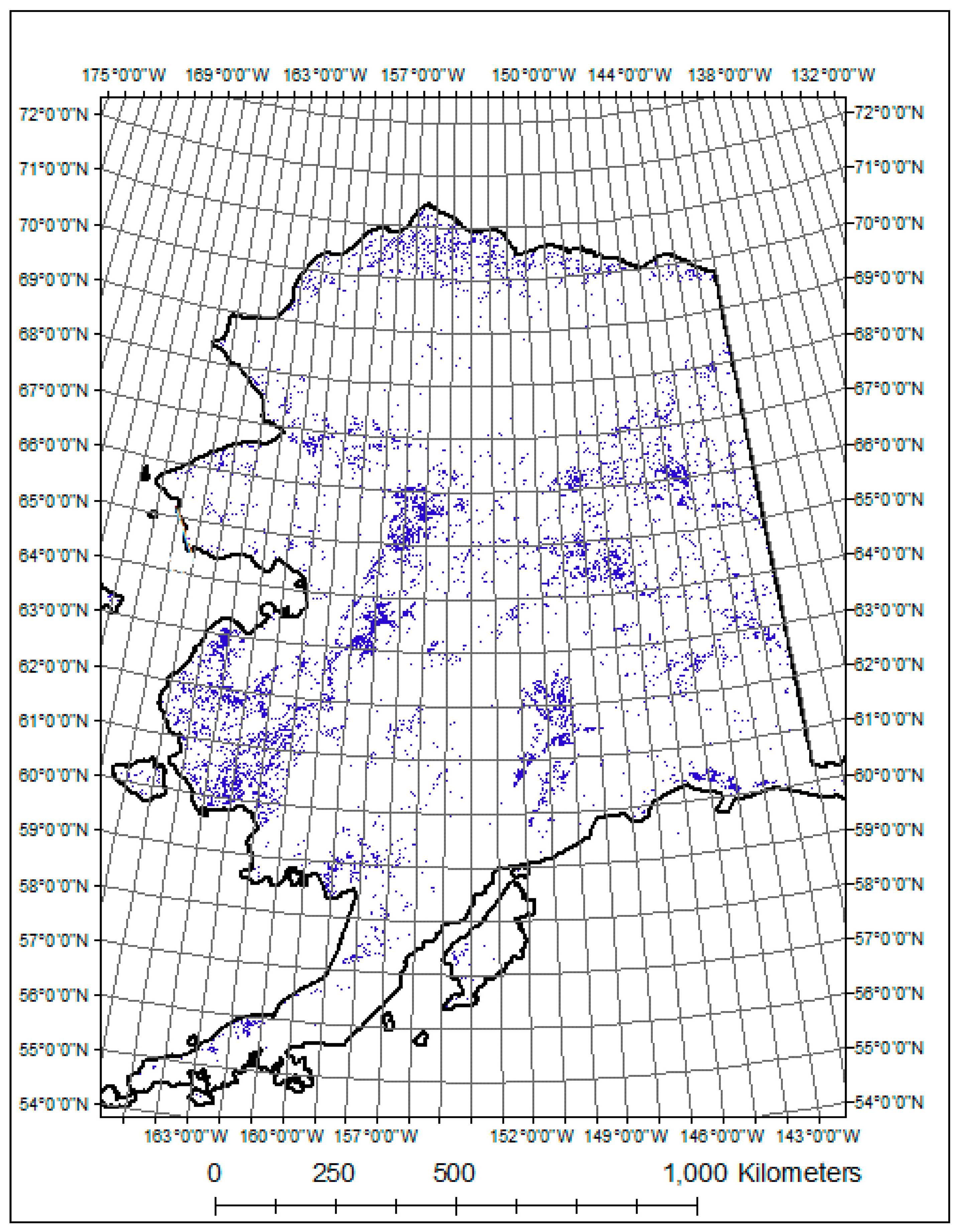
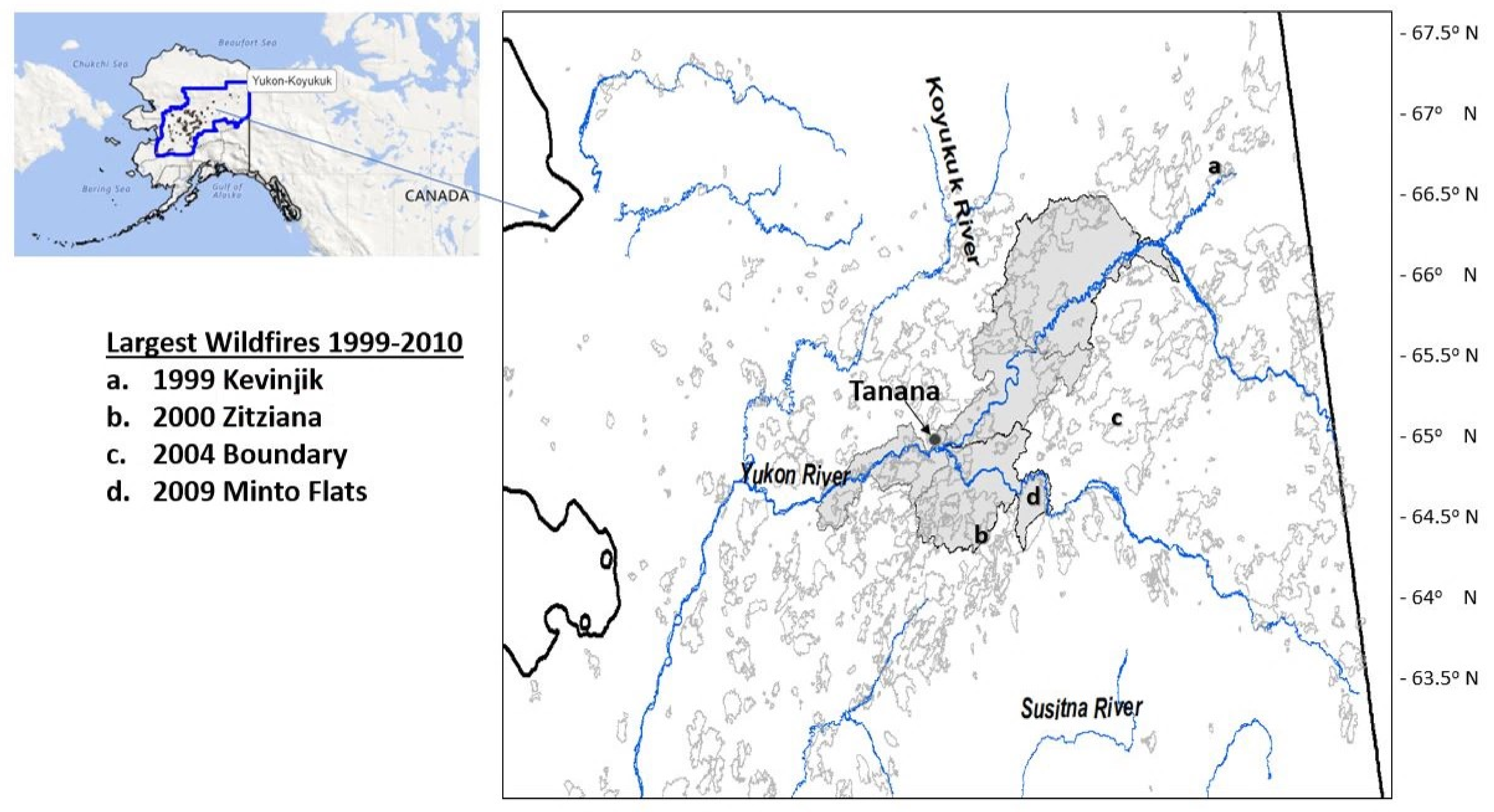
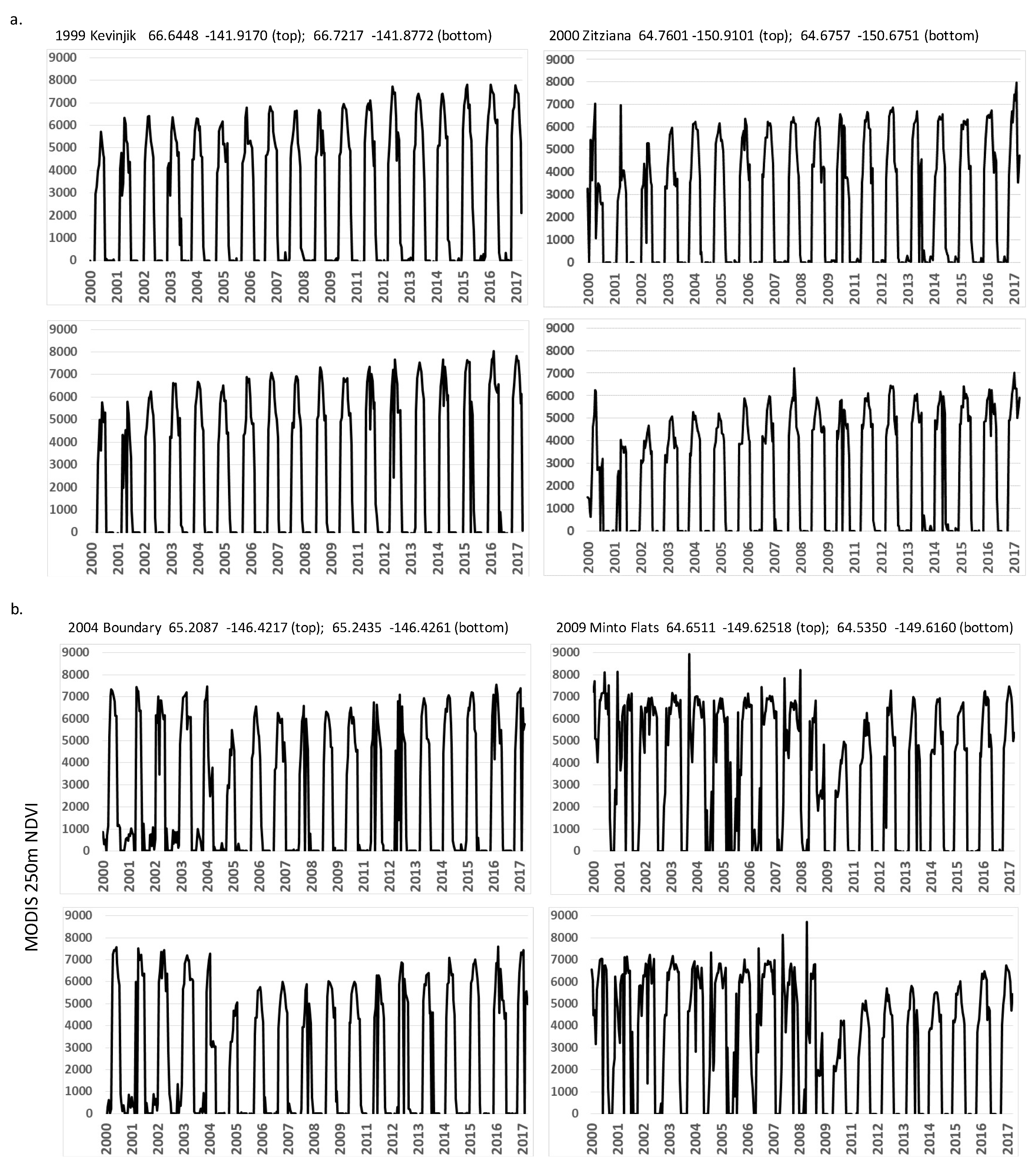
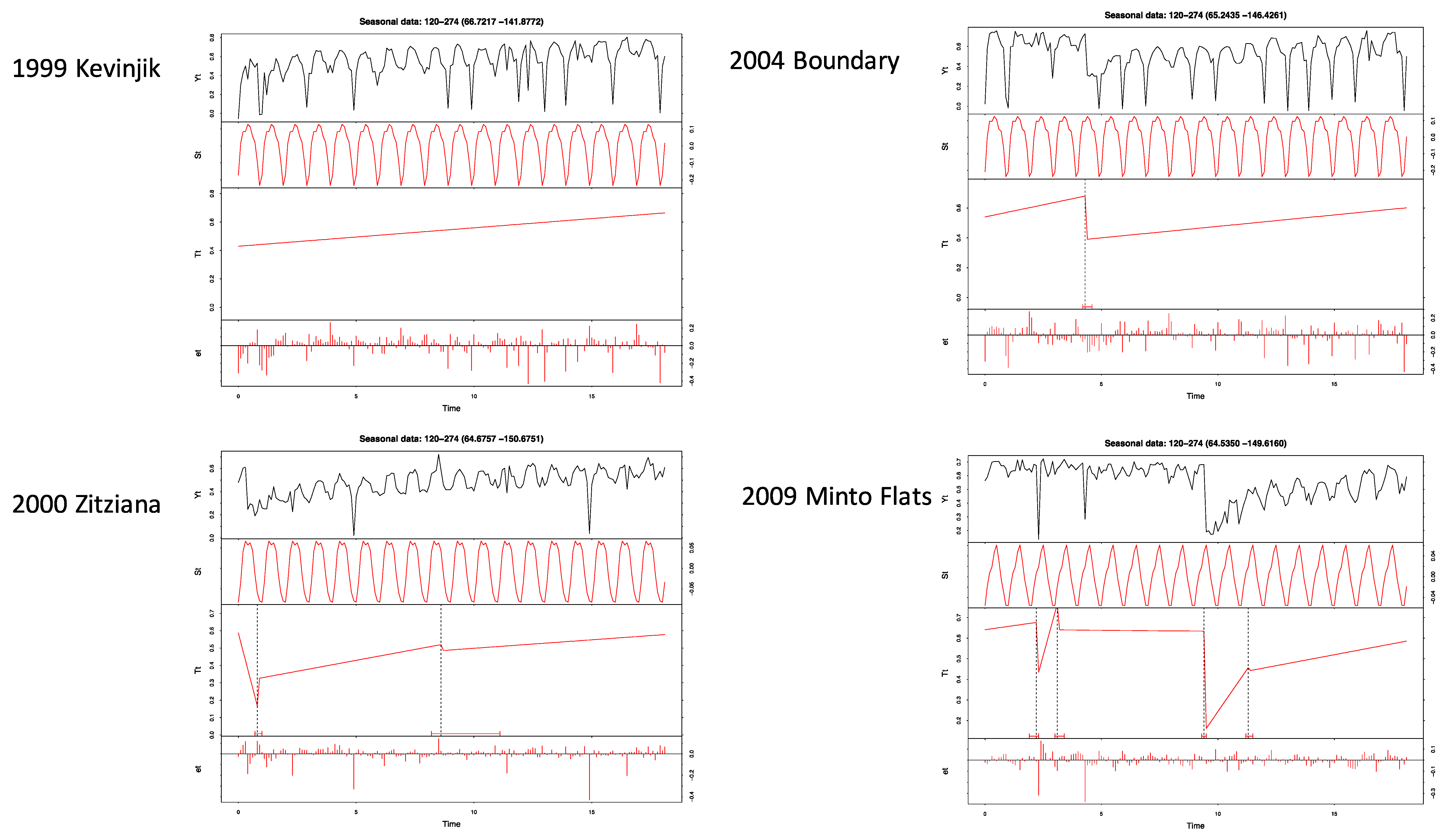

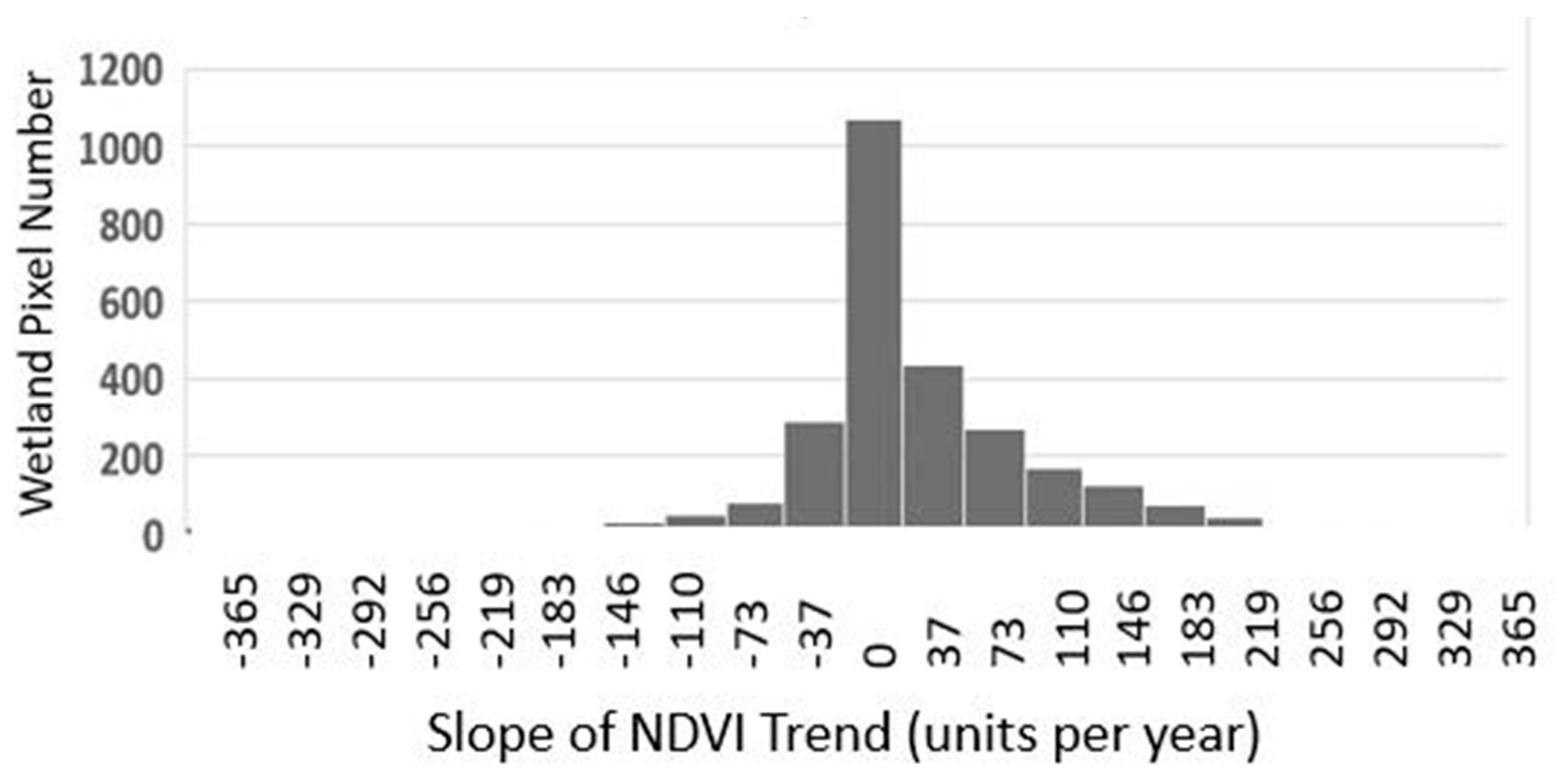
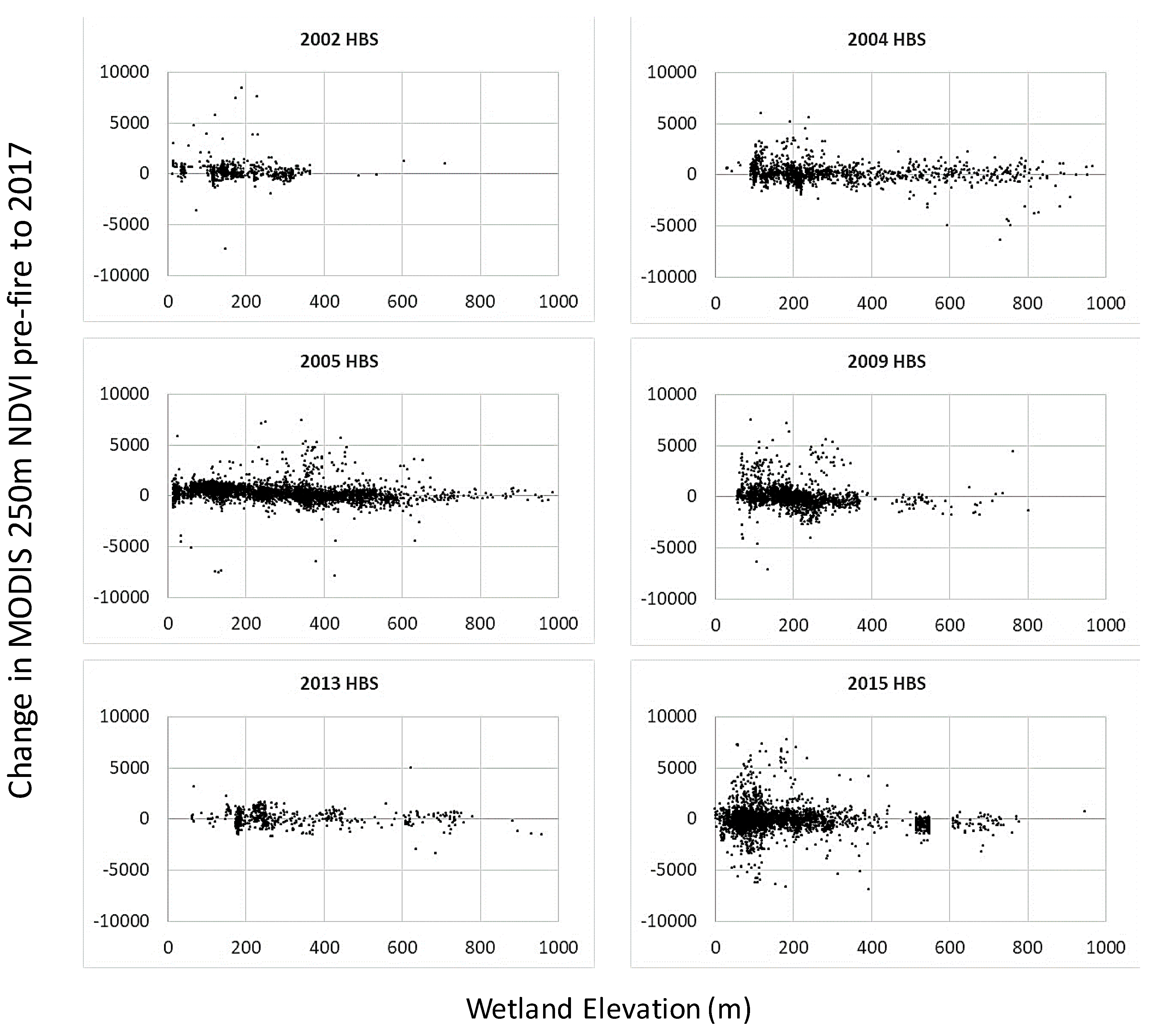
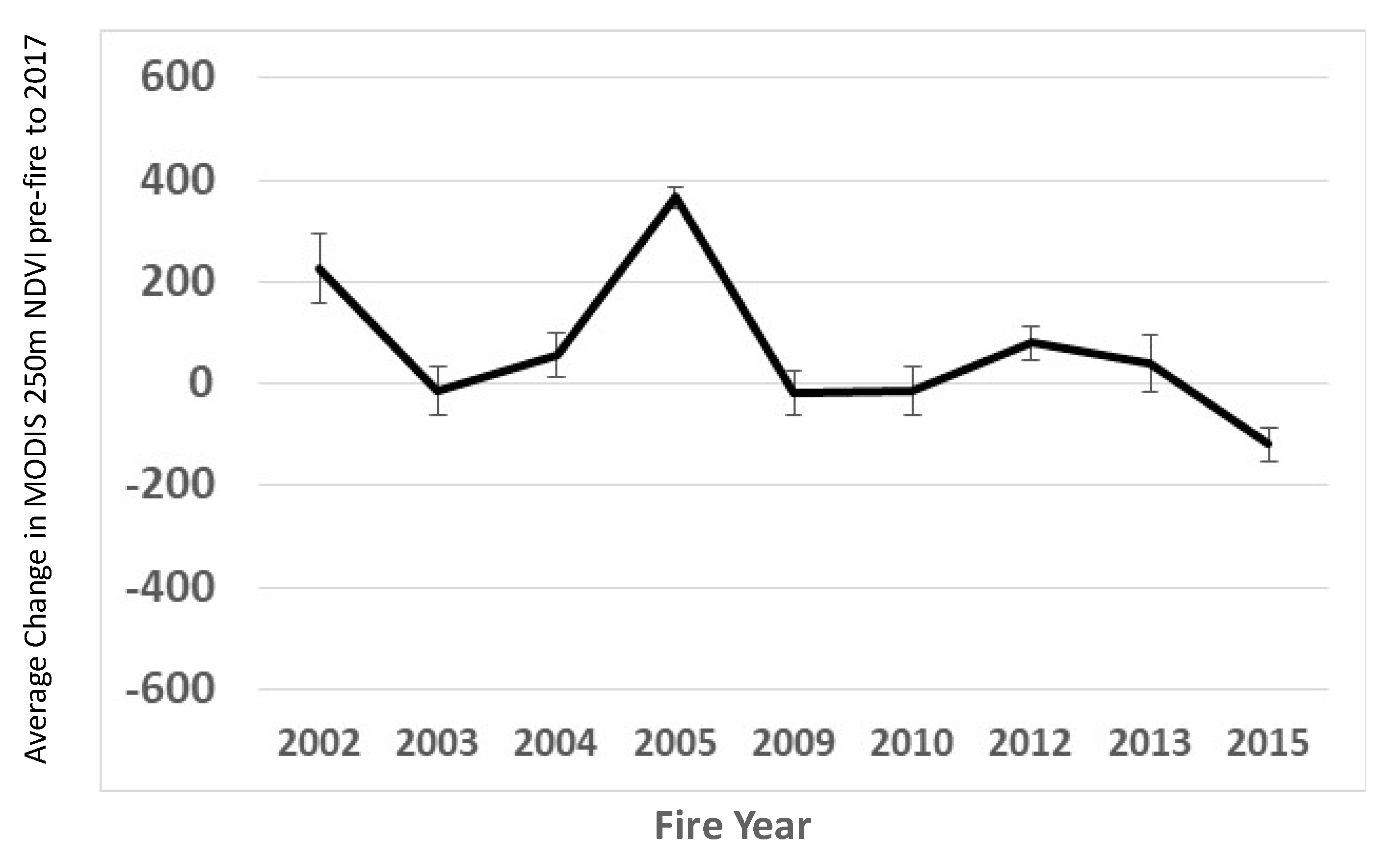
| Overall Slope (da−1) | Breakpoint 1 | Breakpoint 2 | Breakpoint 3 | Breakpoint 4 | |||||
|---|---|---|---|---|---|---|---|---|---|
| Date 1 | Slope 1 | Date 2 | Slope 2 | Date 3 | Slope 3 | Date 4 | Slope 4 | ||
| Kevinjik 1999 | 0.0012 | none | |||||||
| 0.0013 | none | ||||||||
| Zitziana 2000 | 10 June 2001 | −0.021 | 12 July 2002 | 0.001 | |||||
| 14 September 2000 | 0.003 | 13 August 2008 | 0.001 | ||||||
| Boundary 2004 | 26 June 2001 | 0.003 | 26 June 2004 | 0.015 | 30 September 2005 | 0.001 | |||
| 26 June 2004 | 0.002 | ||||||||
| Minto Flats 2009 | 0.0005 | none | |||||||
| 10 June 2002 | 0.039 | 25 May 2003 | 0.000 | 12 July 2009 | 0.011 | 26 June 2011 | 0.002 | ||
© 2018 by the author. Licensee MDPI, Basel, Switzerland. This article is an open access article distributed under the terms and conditions of the Creative Commons Attribution (CC BY) license (http://creativecommons.org/licenses/by/4.0/).
Share and Cite
Potter, C. Recovery Rates of Wetland Vegetation Greenness in Severely Burned Ecosystems of Alaska Derived from Satellite Image Analysis. Remote Sens. 2018, 10, 1456. https://doi.org/10.3390/rs10091456
Potter C. Recovery Rates of Wetland Vegetation Greenness in Severely Burned Ecosystems of Alaska Derived from Satellite Image Analysis. Remote Sensing. 2018; 10(9):1456. https://doi.org/10.3390/rs10091456
Chicago/Turabian StylePotter, Christopher. 2018. "Recovery Rates of Wetland Vegetation Greenness in Severely Burned Ecosystems of Alaska Derived from Satellite Image Analysis" Remote Sensing 10, no. 9: 1456. https://doi.org/10.3390/rs10091456
APA StylePotter, C. (2018). Recovery Rates of Wetland Vegetation Greenness in Severely Burned Ecosystems of Alaska Derived from Satellite Image Analysis. Remote Sensing, 10(9), 1456. https://doi.org/10.3390/rs10091456




